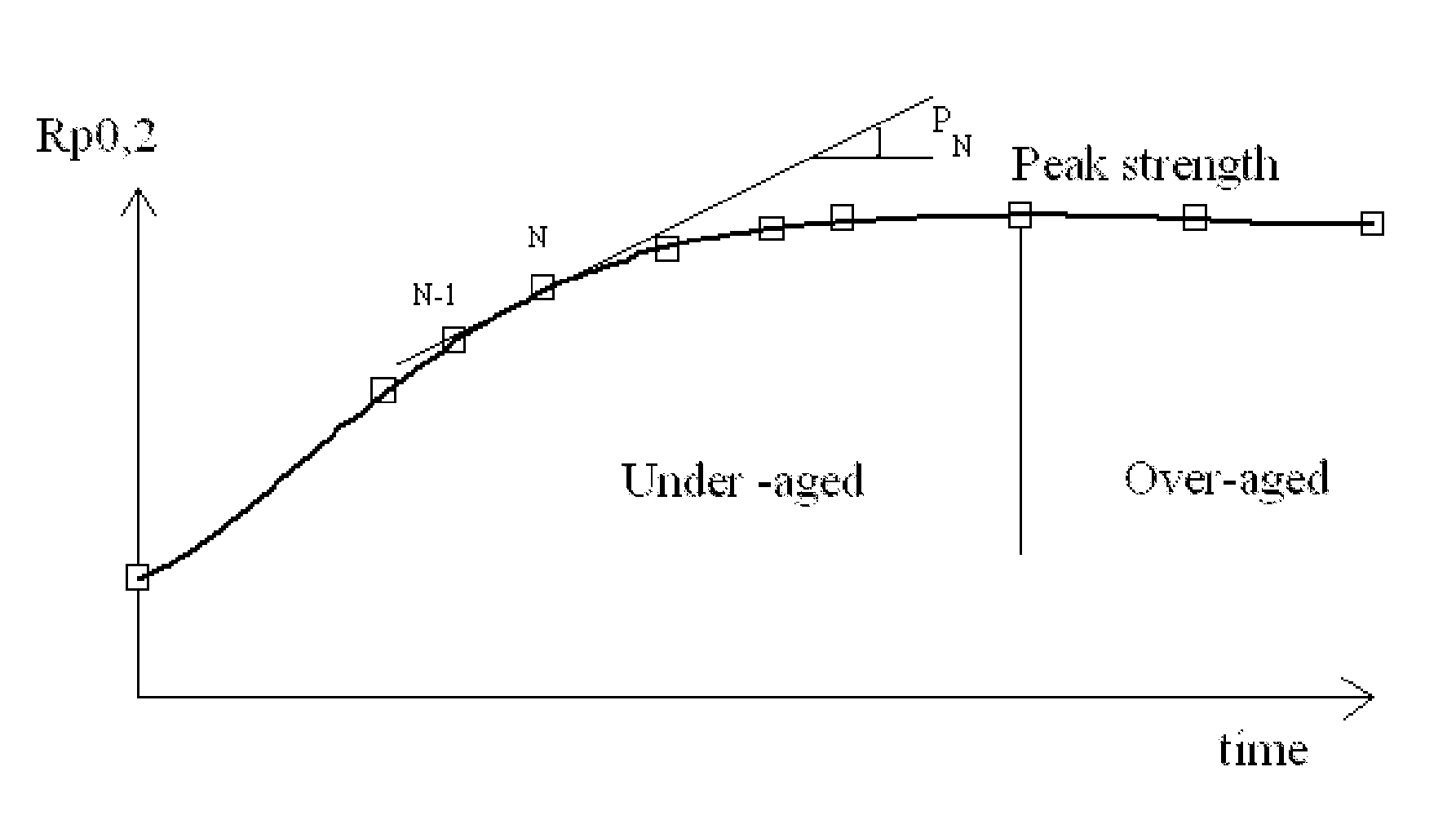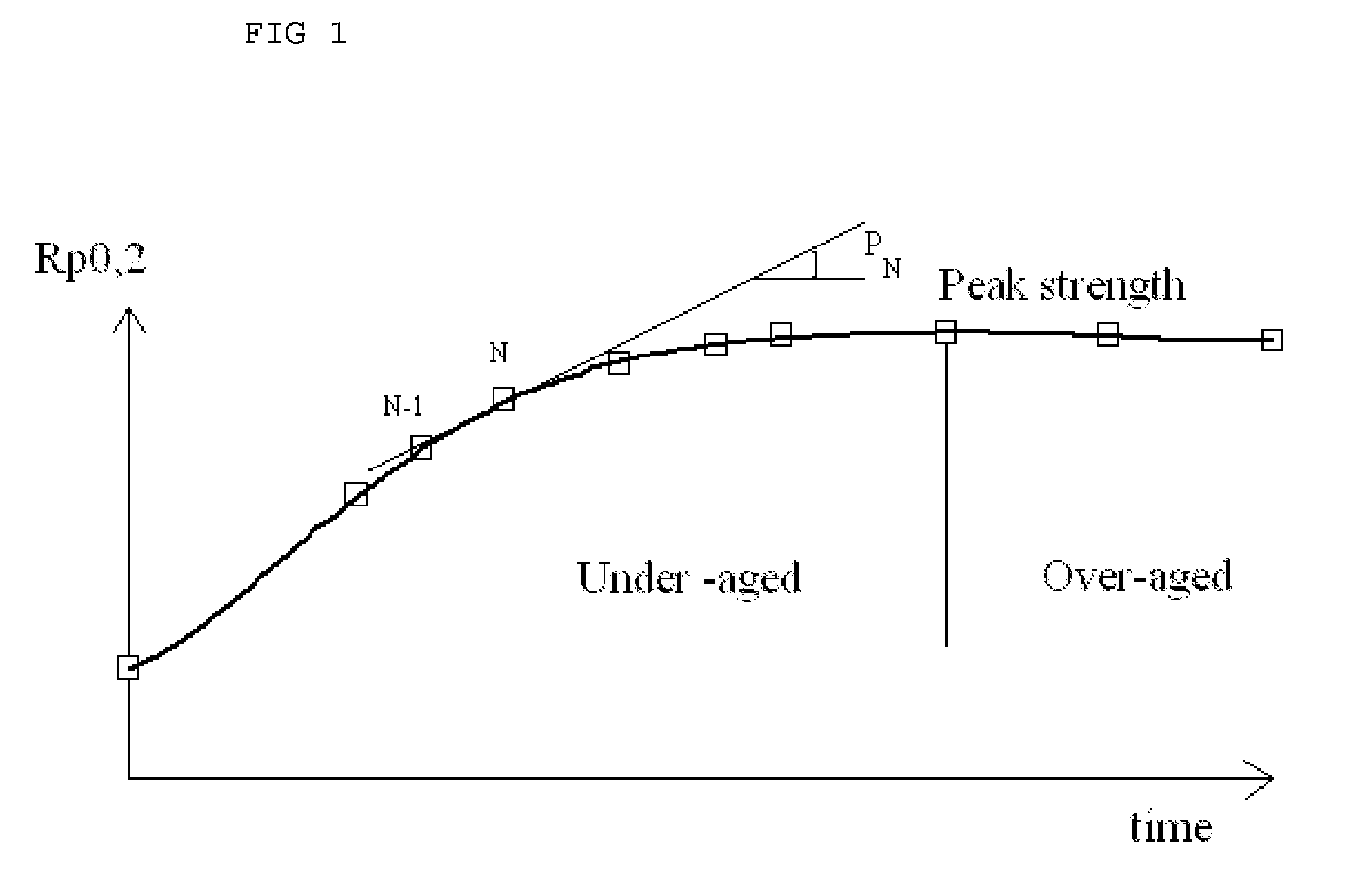Casting process for aluminum alloys
a technology of aluminum alloy and casting process, applied in the field of aluminumcopperlithium alloy products, can solve the problems of quench sensitive products, yield strength decline, and inability to meet the needs of customers,
- Summary
- Abstract
- Description
- Claims
- Application Information
AI Technical Summary
Benefits of technology
Problems solved by technology
Method used
Image
Examples
example 1
[0096]In this example, a plurality of slabs with dimensions 2000×380×120 mm of which the composition is provided in table 1 were cast.
TABLE 1Composition in weight % and density of Al—Cu—Li alloys cast in plate form.DensitySiFeCuMnMgZnAgLiZr(g / cm3)10.0120.0223.540.380.32—0.240.890.102,706(Ref)20.0120.0233.530.380.32——0.910.102,699(Ref)30.0120.0323.530.380.67—0.250.930.102,698(Inv)40.0110.0223.50.380.67——0.940.102,692(Inv)50.0780.0883.520.380.34—0.250.910.102,705(Ref)60.0150.0293.500.390.310.390.240.950.102,707(Ref)(Ref: reference; Inv: invention).Ti: target 0.02% by weight for alloys 1 to 6
[0097]The slabs were homogenized at around 500° C. for around 12 hours, then cut and scalped so as to obtain parts with dimensions of 400×335×90 mm. The parts were hot rolled to obtain plates with a thickness of 20 mm. The plates were solution treated at 505+ / −2° C. for 1 h, quenched with water at 75° C. so as to obtain a cooling rate of around 18° C. / s and thus simulate the properties obtained at ...
example 2
Reference
[0101]In this example, a plurality of slabs with a thickness of 406 mm of which the composition is provided in table 3 were cast.
TABLE 3Composition in weight % and density of Al—Cu—Li alloys cast in plate form.DensityAlloySiFeCuMnMgZnAgLiZr(g / cm3) 820500.030.063.510.410.30.020.370.840.092,713(Ref)211183 921950.030.044.20.40.351.060.112,700(Ref)1764721021950.030.053.870.020.310.010.351.060.112,695(Ref)271257
[0102]The slabs were homogenized, then scalped. After homogenization, the slabs were hot rolled in order to obtain plates with a thickness of 50 mm. The plates were solution treated, quenched with cold water and stretched with a permanent elongation of between 3.5% and 4.5%
[0103]The plates were then subjected to aging for between 10 h and 50 h at 155° C. Samples were obtained at half-thickness in order to measure the static mechanical tensile properties as well as the toughness KQ. The test pieces used to measure the toughness had a width W=80 mm and a thickness B=40 mm. ...
example 3
[0105]In this example, a plurality of slabs with dimensions 2000×380×120 mm of which the composition is provided in table 5 were cast.
TABLE 5Composition in weight % and density of Al—Cu—Li alloys cast in plate form.DensitySiFeCuMnMgZnAgLiTiZr(g / cm3)110.0350.0593.560.350.32—0.250.900.030.112,706(Ref)120.0350.0583.660.350.68—0.250.890.020.122,702(Inv)130.0360.0593.570.341.16—0.250.860.020.122,697(Ref)(Ref: reference; Inv: invention).
[0106]The slabs were homogenized at around 500° C. for around 12 hours, then cut and scalped so as to obtain parts with dimensions of 400×335×90 mm. The parts were hot rolled to obtain plates with a thickness of 20 mm. The plates were solution treated at 505+ / −2° C. for 1 h, and quenched with cold water. The plates were then stretched with a permanent elongation of 3.5%.
[0107]The plates were subjected to artificial aging for between 18 h and 72 h at 155° C. Samples were taken at half-thickness in order to measure the static mechanical tensile properties as...
PUM
| Property | Measurement | Unit |
|---|---|---|
| density | aaaaa | aaaaa |
| thickness | aaaaa | aaaaa |
| thicknesses | aaaaa | aaaaa |
Abstract
Description
Claims
Application Information
 Login to View More
Login to View More - R&D
- Intellectual Property
- Life Sciences
- Materials
- Tech Scout
- Unparalleled Data Quality
- Higher Quality Content
- 60% Fewer Hallucinations
Browse by: Latest US Patents, China's latest patents, Technical Efficacy Thesaurus, Application Domain, Technology Topic, Popular Technical Reports.
© 2025 PatSnap. All rights reserved.Legal|Privacy policy|Modern Slavery Act Transparency Statement|Sitemap|About US| Contact US: help@patsnap.com



